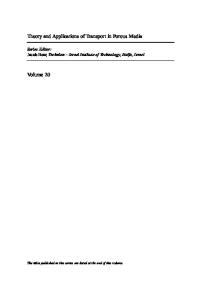Critical Fluids in Porous Media
- PDF / 841,918 Bytes
- 6 Pages / 576 x 792 pts Page_size
- 41 Downloads / 339 Views
MRS BULLETIN/MAY 1994
tails, and which are system specific. Confined critical systems are also interesting in their own right because they provide an intriguing means of investigating the statistical mechanics of mesoscopic systems. For such systems, the ratio of surface area to volume does not vanish as the total sample volume increases without limit, and thus they do not approach the normal thermodynamic limit. Consequently their behavior may not be predictable by arguments involving the scaling of bulk behavior, which are predicated on the neglect of surface energies. Indeed, experiments show that phase behavior is profoundly altered in porous media in ways that are not yet understood, even when the confining medium occupies only a few percent of the total volume. In this article, we attempt to summarize the gen-
one—phase region
critical ^ point coexistence curve
s t r -'
/
two-phase coexistence region
Density or Concentration
Figure 1. Schematic phase diagram for a pure fluid near the gas-liquid critical point or for a binary liquid mixture near the consolute critical point. According to the modern theory of critical phenomena, both systems belong to the same universality class, that of the Ising magnet, and therefore have the same exponent values describing the power-law behavior observed near the critical point.
\
eral features that have been observed in experiments, and to spell out the conceptual ingredients whose effects require elucidation in future experiments, and which must be included in any theoretical description. Before describing some of the effects porous media have on critical phenomena, we will provide a brief summary of relevant critical phenomena in unconfined systems in the next section, as well as a list of the types of porous media that have been studied. We then introduce important concepts that must be understood to consider the behavior of confined fluids. The final sections summarize experimental results and theoretical approaches that have been attempted. Review of Critical Phenomena and Types of Porous Media Critical Phenomena Pure fluids form a single phase at temperatures above a critical temperature, Tc. For T < Tc, the system consists of two phases, vapor and liquid, if held exactly at the vapor pressure. These two phases will also coexist in a sample that has been prepared at a fixed density between those of the liquid and vapor phases, rather than at fixed pressure. The coexisting phases differ in density, but this difference goes smoothly to zero as the temperature is raised to Tc, varying as \T - Tc\p, where the critical exponent /3 is approximately 0.32.12 The common density approached by both phases is called the critical density, and the simultaneous realization of that density and the critical temperature defines the critical point. This behavior is indicated schematically in Figure 1. The behavior of binary liquid mixtures near the consolute critical point is exactly analogous. For T > Tc, the two components may be mixed in any proportion, yielding a single-ph
Data Loading...











